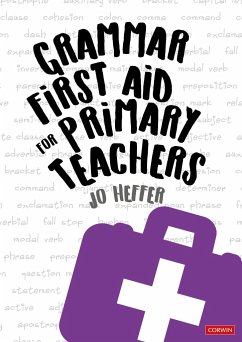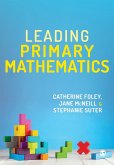Jo Heffer
Grammar First Aid for Primary Teachers
Jo Heffer
Grammar First Aid for Primary Teachers
- Broschiertes Buch
- Merkliste
- Auf die Merkliste
- Bewerten Bewerten
- Teilen
- Produkt teilen
- Produkterinnerung
- Produkterinnerung
Fronted adverbials?
Relative clauses?
Perfect tenses?
Subjunctive form?
How can teachers teach all the grammar and punctuation requirements in the primary National Curriculum in a way that pupils want to learn about them?
This book provides clear explanations, structured introductory teaching sequences and practical consolidation activities that cover all KS2 statutory requirements and makes learning memorable.
Andere Kunden interessierten sich auch für
![Mastery Mathematics for Primary Teachers Mastery Mathematics for Primary Teachers]() Robert NewellMastery Mathematics for Primary Teachers25,99 €
Robert NewellMastery Mathematics for Primary Teachers25,99 €![Mastery Mathematics for Primary Teachers Mastery Mathematics for Primary Teachers]() Robert NewellMastery Mathematics for Primary Teachers74,99 €
Robert NewellMastery Mathematics for Primary Teachers74,99 €![Observing Primary Literacy Observing Primary Literacy]() Margaret PerkinsObserving Primary Literacy30,99 €
Margaret PerkinsObserving Primary Literacy30,99 €![Learning Science by Doing Science Learning Science by Doing Science]() Alan ColburnLearning Science by Doing Science31,99 €
Alan ColburnLearning Science by Doing Science31,99 €![Leading Primary Mathematics Leading Primary Mathematics]() Catherine FoleyLeading Primary Mathematics31,99 €
Catherine FoleyLeading Primary Mathematics31,99 €![Inspiring Writing in Primary Schools Inspiring Writing in Primary Schools]() Liz ChamberlainInspiring Writing in Primary Schools27,99 €
Liz ChamberlainInspiring Writing in Primary Schools27,99 €![Inspiring Writing in Primary Schools Inspiring Writing in Primary Schools]() Liz ChamberlainInspiring Writing in Primary Schools89,99 €
Liz ChamberlainInspiring Writing in Primary Schools89,99 €-
-
-
Fronted adverbials?
Relative clauses?
Perfect tenses?
Subjunctive form?
How can teachers teach all the grammar and punctuation requirements in the primary National Curriculum in a way that pupils want to learn about them?
This book provides clear explanations, structured introductory teaching sequences and practical consolidation activities that cover all KS2 statutory requirements and makes learning memorable.
Relative clauses?
Perfect tenses?
Subjunctive form?
How can teachers teach all the grammar and punctuation requirements in the primary National Curriculum in a way that pupils want to learn about them?
This book provides clear explanations, structured introductory teaching sequences and practical consolidation activities that cover all KS2 statutory requirements and makes learning memorable.
Produktdetails
- Produktdetails
- Verlag: Corwin UK / Sage Publications
- Seitenzahl: 192
- Erscheinungstermin: 23. September 2020
- Englisch
- Abmessung: 297mm x 210mm x 11mm
- Gewicht: 517g
- ISBN-13: 9781529730432
- ISBN-10: 1529730430
- Artikelnr.: 59181824
- Herstellerkennzeichnung
- Libri GmbH
- Europaallee 1
- 36244 Bad Hersfeld
- gpsr@libri.de
- Verlag: Corwin UK / Sage Publications
- Seitenzahl: 192
- Erscheinungstermin: 23. September 2020
- Englisch
- Abmessung: 297mm x 210mm x 11mm
- Gewicht: 517g
- ISBN-13: 9781529730432
- ISBN-10: 1529730430
- Artikelnr.: 59181824
- Herstellerkennzeichnung
- Libri GmbH
- Europaallee 1
- 36244 Bad Hersfeld
- gpsr@libri.de
Jo Heffer has worked as a teacher, literacy subject leader and education consultant for thirty years. She currently works part time for Windsor and Maidenhead as an advisor and assessment manager alongside working as an independent literacy consultant. Her passion for literacy has taken her to many parts of England to run successful courses on teaching grammar and punctuation as well as all other aspects of literacy.
Introduction
Part 1 The Basics: Building on KS1 and EYFS
1.1 Words
1.2 Sentences, texts and punctuation
Part 2 Teaching grammar in years 3 and 4
2.1 A Framework for teaching the Year 3/4 statutory requirements
2.2 Extending the range of sentences with more than one clause by using a wider range of conjunctions, including when, if, because, although
2.3 Using the present perfect form of verbs in contrast to the past tense
2.4 Choosing nouns or pronouns appropriately for clarity and cohesion and to avoid repetition
2.5 Using conjunctions, adverbs and prepositions to express time and cause
2.6 Using fronted adverbials and Using commas after fronted adverbials
2.7 Year 3 and 4 punctuation
Part 3 Teaching grammar in years 5 and 6
3.1 The Y5/6 statutory requirements
3.2 Recognising vocabulary and structures that are appropriate for formal speech and writing, including subjunctive forms
3.3 Using passive verbs to affect the presentation of information in a sentence
3.4 Using the perfect form of verbs to mark relationships of time and cause
3.5 Using expanded noun phrases to convey complicated information concisely
3.6 Using modal verbs or adverbs to indicate degrees of possibility
3.7 Using relative clauses beginning with who, which, where, when, whose, that or using an implied (i.e. omitted) pronoun
3.8 Year 5 and 6 punctuation
Part 4 You've taught it but have they learnt it?
Finding Examples in Reading - Book list
A glossary of terms
Part 1 The Basics: Building on KS1 and EYFS
1.1 Words
1.2 Sentences, texts and punctuation
Part 2 Teaching grammar in years 3 and 4
2.1 A Framework for teaching the Year 3/4 statutory requirements
2.2 Extending the range of sentences with more than one clause by using a wider range of conjunctions, including when, if, because, although
2.3 Using the present perfect form of verbs in contrast to the past tense
2.4 Choosing nouns or pronouns appropriately for clarity and cohesion and to avoid repetition
2.5 Using conjunctions, adverbs and prepositions to express time and cause
2.6 Using fronted adverbials and Using commas after fronted adverbials
2.7 Year 3 and 4 punctuation
Part 3 Teaching grammar in years 5 and 6
3.1 The Y5/6 statutory requirements
3.2 Recognising vocabulary and structures that are appropriate for formal speech and writing, including subjunctive forms
3.3 Using passive verbs to affect the presentation of information in a sentence
3.4 Using the perfect form of verbs to mark relationships of time and cause
3.5 Using expanded noun phrases to convey complicated information concisely
3.6 Using modal verbs or adverbs to indicate degrees of possibility
3.7 Using relative clauses beginning with who, which, where, when, whose, that or using an implied (i.e. omitted) pronoun
3.8 Year 5 and 6 punctuation
Part 4 You've taught it but have they learnt it?
Finding Examples in Reading - Book list
A glossary of terms
Introduction
Part 1 The Basics: Building on KS1 and EYFS
1.1 Words
1.2 Sentences, texts and punctuation
Part 2 Teaching grammar in years 3 and 4
2.1 A Framework for teaching the Year 3/4 statutory requirements
2.2 Extending the range of sentences with more than one clause by using a wider range of conjunctions, including when, if, because, although
2.3 Using the present perfect form of verbs in contrast to the past tense
2.4 Choosing nouns or pronouns appropriately for clarity and cohesion and to avoid repetition
2.5 Using conjunctions, adverbs and prepositions to express time and cause
2.6 Using fronted adverbials and Using commas after fronted adverbials
2.7 Year 3 and 4 punctuation
Part 3 Teaching grammar in years 5 and 6
3.1 The Y5/6 statutory requirements
3.2 Recognising vocabulary and structures that are appropriate for formal speech and writing, including subjunctive forms
3.3 Using passive verbs to affect the presentation of information in a sentence
3.4 Using the perfect form of verbs to mark relationships of time and cause
3.5 Using expanded noun phrases to convey complicated information concisely
3.6 Using modal verbs or adverbs to indicate degrees of possibility
3.7 Using relative clauses beginning with who, which, where, when, whose, that or using an implied (i.e. omitted) pronoun
3.8 Year 5 and 6 punctuation
Part 4 You've taught it but have they learnt it?
Finding Examples in Reading - Book list
A glossary of terms
Part 1 The Basics: Building on KS1 and EYFS
1.1 Words
1.2 Sentences, texts and punctuation
Part 2 Teaching grammar in years 3 and 4
2.1 A Framework for teaching the Year 3/4 statutory requirements
2.2 Extending the range of sentences with more than one clause by using a wider range of conjunctions, including when, if, because, although
2.3 Using the present perfect form of verbs in contrast to the past tense
2.4 Choosing nouns or pronouns appropriately for clarity and cohesion and to avoid repetition
2.5 Using conjunctions, adverbs and prepositions to express time and cause
2.6 Using fronted adverbials and Using commas after fronted adverbials
2.7 Year 3 and 4 punctuation
Part 3 Teaching grammar in years 5 and 6
3.1 The Y5/6 statutory requirements
3.2 Recognising vocabulary and structures that are appropriate for formal speech and writing, including subjunctive forms
3.3 Using passive verbs to affect the presentation of information in a sentence
3.4 Using the perfect form of verbs to mark relationships of time and cause
3.5 Using expanded noun phrases to convey complicated information concisely
3.6 Using modal verbs or adverbs to indicate degrees of possibility
3.7 Using relative clauses beginning with who, which, where, when, whose, that or using an implied (i.e. omitted) pronoun
3.8 Year 5 and 6 punctuation
Part 4 You've taught it but have they learnt it?
Finding Examples in Reading - Book list
A glossary of terms









